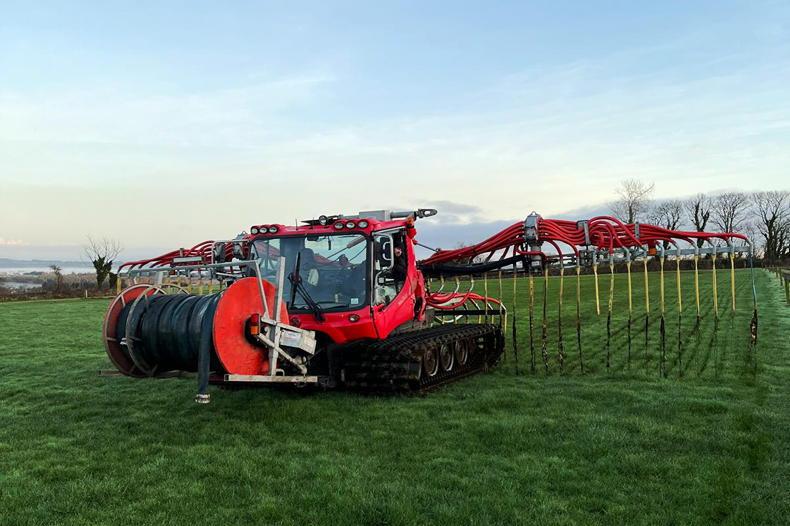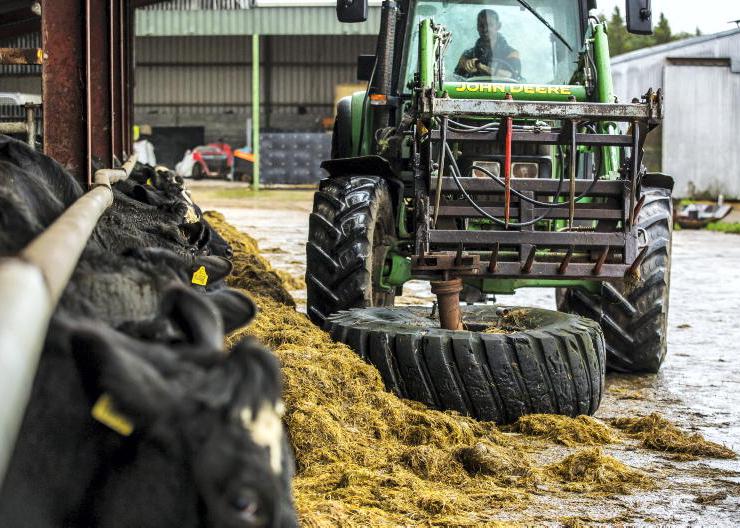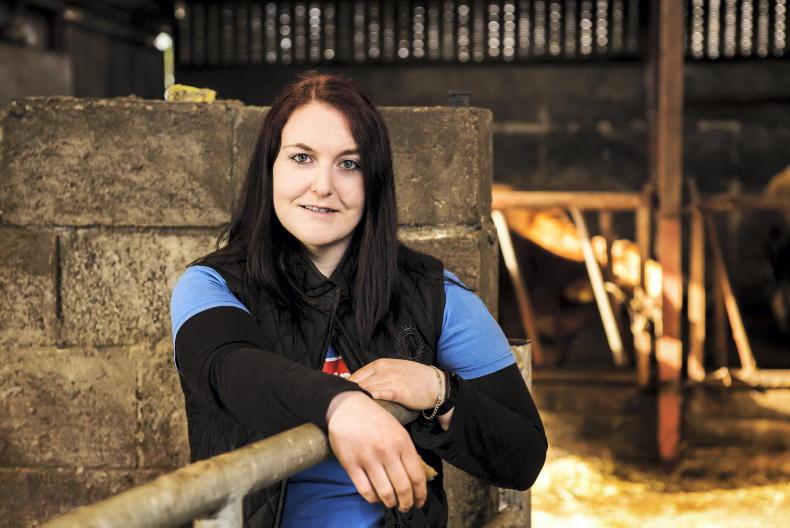In the winter time, silage quality was tested on the Footprint Farms and while all farms had good-quality silage, there was also a lot of poor-quality silage on farms.
With inputs like fertiliser and concentrates at extremely high prices, it is essential that farmers focus on producing the best-quality silage they can and maximise yields as far as possible.
This year, we are aiming to improve silage quality on those farms and Irish Farmers Journal livestock specialist Kieran Mailey offered advice on a recent webinar.
The first thing that stood out for Kieran was that while we talk about high-quality silage, every farm has a different method of defining high-quality silage depending on its system.
For example, a farmer that is primarily feeding dry spring calving cows all winter requires a different quality of silage to a farmer feeding autumn calving cows or finishing stores.
In terms of quality versus quantity, there is a balancing point required. There is no point focusing solely on high quality forage, only to run short of fodder as yields were too low. In terms of feed value, good silage tends to be around:
Dry matter – 28-32%.Energy – 11.5-12 ME MJ/kg DM.Crude protein – 14-16%.DMD – 70-74%.pH – 4 (4.5-5 for high-DM silage)Ammonia – 5-10%.Fibre (NDF) – 48-50%.He added that a silage sample is a guide, therefore, a second or third sample should be taken midway through winter. He listed five factors which affect silage quality;
Five factors that influence silage quality:
Cutting date.Wilting period.Harvesting method.Ensiling method.Preservation and pit management at feed-out.1 Cutting date
On cutting date, Kieran noted that there are a few things to check. The first is the amount of nitrogen (N) spread. The general rule of thumb is that two units of N will be used per day, but this will generally balance out. If weather was cold early in the season, more N will be taken up later when temperatures rise.
Grass should be cut once seed heads start to emerge, as dry matter digestibility (DMD) falls by approximately 0.5%/day once grass starts to head out. Over the course of a week, that’s a drop of 3.5% – a drop of 4% in DMD is the equivalent of having to feed 1kg-1.5kg extra concentrate to make up the deficit.
It is also important to check the bottom of the grass. It should be cut before it turns white or brown. If the grass at the bottom of the sward is dead, it will affect the quality of the silage and regrowth for the second cut.
2 Wilting
The purpose of wilting is to increase dry matter to 30% as soon as possible. The faster that you wilt the grass, the more sugars you will retain and the better fermentation will be.
Normally, the advice is mow in the afternoon and wilt for 24 hours before lifting grass. Wilting beyond 24 hours increases sugar losses and leads to a poorer fermentation.
However, there will be spells when temperatures are well over 20 degrees. On such days, grass can be mown in the morning, tedded out and lifted that evening.
Crops like red clover, however, need to wilt for about 36 hours and should not be tedded.
3 Harvesting
When it comes to harvesting, chop length is important. If it is too short, it will be harder to ensile as it will be difficult to get the air out of the pit.
30% DM silage – approximately 5cm chop length.25-30% DM silage – 8cm-10cm chop length.<25% DM silage – 10cm and chop length.If baling silage, the chop length will determine the density of the bale. Kieran advised wrapping and stacking as soon as possible, but avoid stacking more than one row high.
4 Ensiling grass and
fermentation
When it comes to ensiling, Kieran noted that it’s important to have the right person on the buckrake and that the first load and the last load should be treated the same. Trailers arriving too quickly can result in a poor filling technique.
He said the pit needs to be filled in even layers approximately 15cm deep to get an even roll.
He also commented that side covers with a big overlap should be used, along with two top sheets – one old and one new. Bales should receive six layers of plastic.
If the clamp is overfilled, losses start to increase once filled above the side walls. The filling angle in the clamp needs to be kept below 20°.
5 Clamp management
The final factor will not be an issue until the silage is to be used. The clamp should be closed for at least two months to allow for proper fermentation.
A sharp shear grab can keep the pit face clean and sealed, and cutting from top to bottom and side to side is recommended.
In the winter time, silage quality was tested on the Footprint Farms and while all farms had good-quality silage, there was also a lot of poor-quality silage on farms.
With inputs like fertiliser and concentrates at extremely high prices, it is essential that farmers focus on producing the best-quality silage they can and maximise yields as far as possible.
This year, we are aiming to improve silage quality on those farms and Irish Farmers Journal livestock specialist Kieran Mailey offered advice on a recent webinar.
The first thing that stood out for Kieran was that while we talk about high-quality silage, every farm has a different method of defining high-quality silage depending on its system.
For example, a farmer that is primarily feeding dry spring calving cows all winter requires a different quality of silage to a farmer feeding autumn calving cows or finishing stores.
In terms of quality versus quantity, there is a balancing point required. There is no point focusing solely on high quality forage, only to run short of fodder as yields were too low. In terms of feed value, good silage tends to be around:
Dry matter – 28-32%.Energy – 11.5-12 ME MJ/kg DM.Crude protein – 14-16%.DMD – 70-74%.pH – 4 (4.5-5 for high-DM silage)Ammonia – 5-10%.Fibre (NDF) – 48-50%.He added that a silage sample is a guide, therefore, a second or third sample should be taken midway through winter. He listed five factors which affect silage quality;
Five factors that influence silage quality:
Cutting date.Wilting period.Harvesting method.Ensiling method.Preservation and pit management at feed-out.1 Cutting date
On cutting date, Kieran noted that there are a few things to check. The first is the amount of nitrogen (N) spread. The general rule of thumb is that two units of N will be used per day, but this will generally balance out. If weather was cold early in the season, more N will be taken up later when temperatures rise.
Grass should be cut once seed heads start to emerge, as dry matter digestibility (DMD) falls by approximately 0.5%/day once grass starts to head out. Over the course of a week, that’s a drop of 3.5% – a drop of 4% in DMD is the equivalent of having to feed 1kg-1.5kg extra concentrate to make up the deficit.
It is also important to check the bottom of the grass. It should be cut before it turns white or brown. If the grass at the bottom of the sward is dead, it will affect the quality of the silage and regrowth for the second cut.
2 Wilting
The purpose of wilting is to increase dry matter to 30% as soon as possible. The faster that you wilt the grass, the more sugars you will retain and the better fermentation will be.
Normally, the advice is mow in the afternoon and wilt for 24 hours before lifting grass. Wilting beyond 24 hours increases sugar losses and leads to a poorer fermentation.
However, there will be spells when temperatures are well over 20 degrees. On such days, grass can be mown in the morning, tedded out and lifted that evening.
Crops like red clover, however, need to wilt for about 36 hours and should not be tedded.
3 Harvesting
When it comes to harvesting, chop length is important. If it is too short, it will be harder to ensile as it will be difficult to get the air out of the pit.
30% DM silage – approximately 5cm chop length.25-30% DM silage – 8cm-10cm chop length.<25% DM silage – 10cm and chop length.If baling silage, the chop length will determine the density of the bale. Kieran advised wrapping and stacking as soon as possible, but avoid stacking more than one row high.
4 Ensiling grass and
fermentation
When it comes to ensiling, Kieran noted that it’s important to have the right person on the buckrake and that the first load and the last load should be treated the same. Trailers arriving too quickly can result in a poor filling technique.
He said the pit needs to be filled in even layers approximately 15cm deep to get an even roll.
He also commented that side covers with a big overlap should be used, along with two top sheets – one old and one new. Bales should receive six layers of plastic.
If the clamp is overfilled, losses start to increase once filled above the side walls. The filling angle in the clamp needs to be kept below 20°.
5 Clamp management
The final factor will not be an issue until the silage is to be used. The clamp should be closed for at least two months to allow for proper fermentation.
A sharp shear grab can keep the pit face clean and sealed, and cutting from top to bottom and side to side is recommended.










SHARING OPTIONS